Abstract
Cytochrome P-450-mediated responses to environmental challenges are well known in diverse animal taxa, but the evolution of the complex gene superfamily coding for these enzymes is poorly understood. Here we report a phylogenetic analysis of the cytochrome P-450 1A (CYP1A) genes including two new sequences determined from teleost fish, toadfish (Opsanus tau) and scup (Stenotomus chrysops). Degenerate PCR primers were used to amplify a 1.2 kbp fragment from liver cDNA. The toadfish PCR product was used as a probe to identify a full-length CYP1A clone from a toadfish liver cDNA library. The entire coding region of the scup CYP1A was obtained by rapid amplification of cDNA ends (RACE) using specific primers based on the sequence of the partial PCR product. The predicted protein sequences for toadfish and scup CYP1A shared 78% and 83% amino acid identity with rainbow trout CYP1A1 respectively. Amino acid identity with mammalian CYP1A proteins ranged from 51 to 60% for 505 aligned positions. Phylogenetic analysis of four teleost fish CYP1A genes (trout, toadfish, scup and plaice) and 12 mammalian CYP1A genes suggests a monophyletic origin of the teleost genes, with the trout gene being most divergent, and indicates three distinct groupings: mammalian 1A1, mammalian 1A2, and fish 1A. This supports the idea that the gene duplication event which gave rise to CYP1A1 and CYP1A2 occurred after the divergence of the lines leading to mammals and fish. These results establish a molecular phylogeny within the CYP1A subfamily, the first such detailed phylogenetic analysis within a cytochrome P-450 family.
Full text
PDF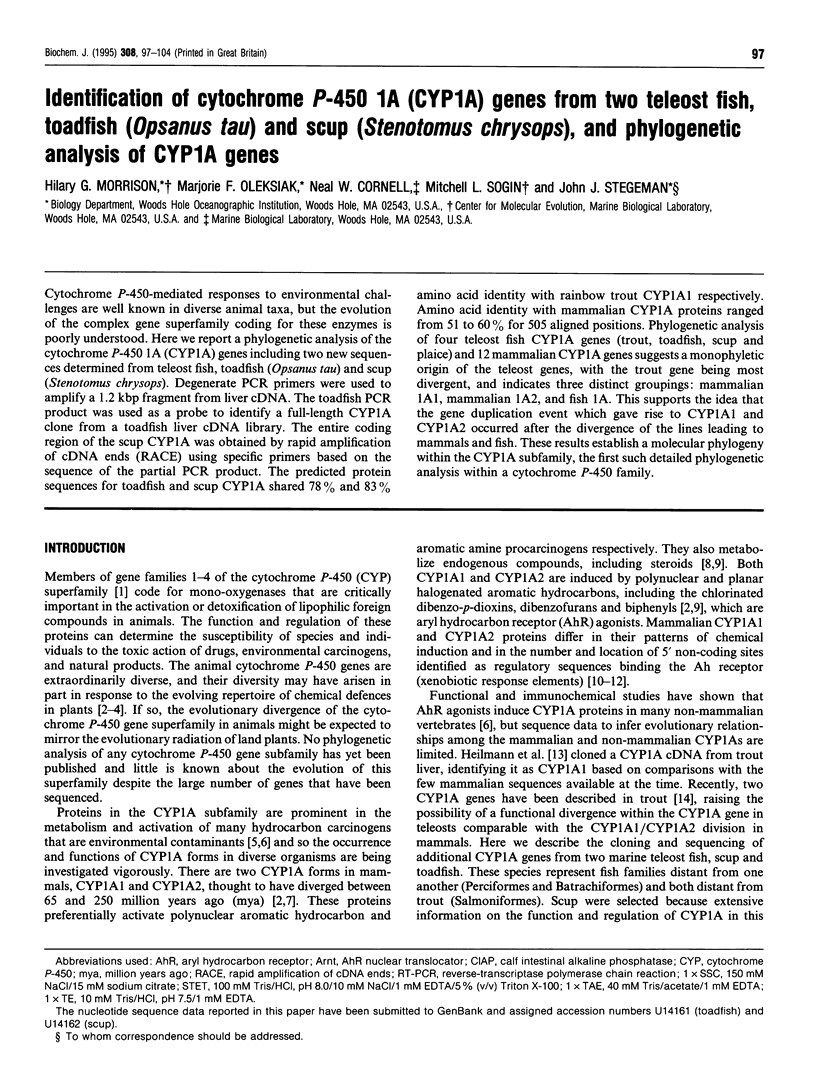
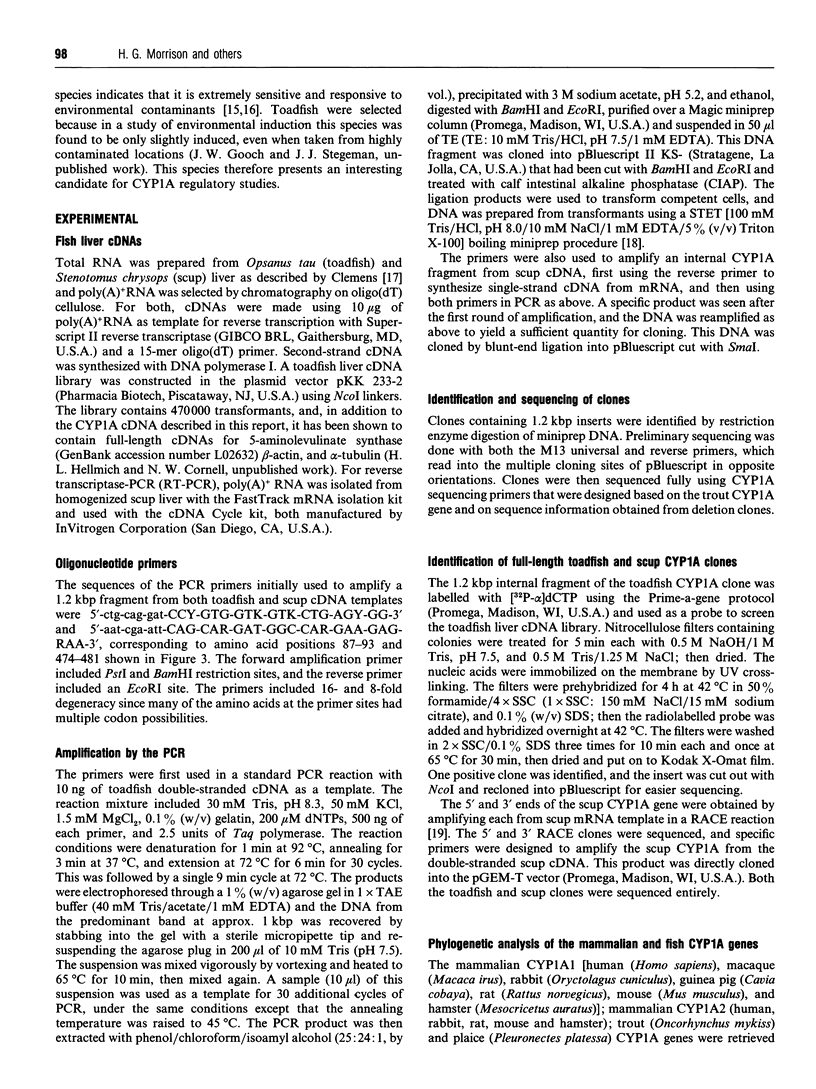
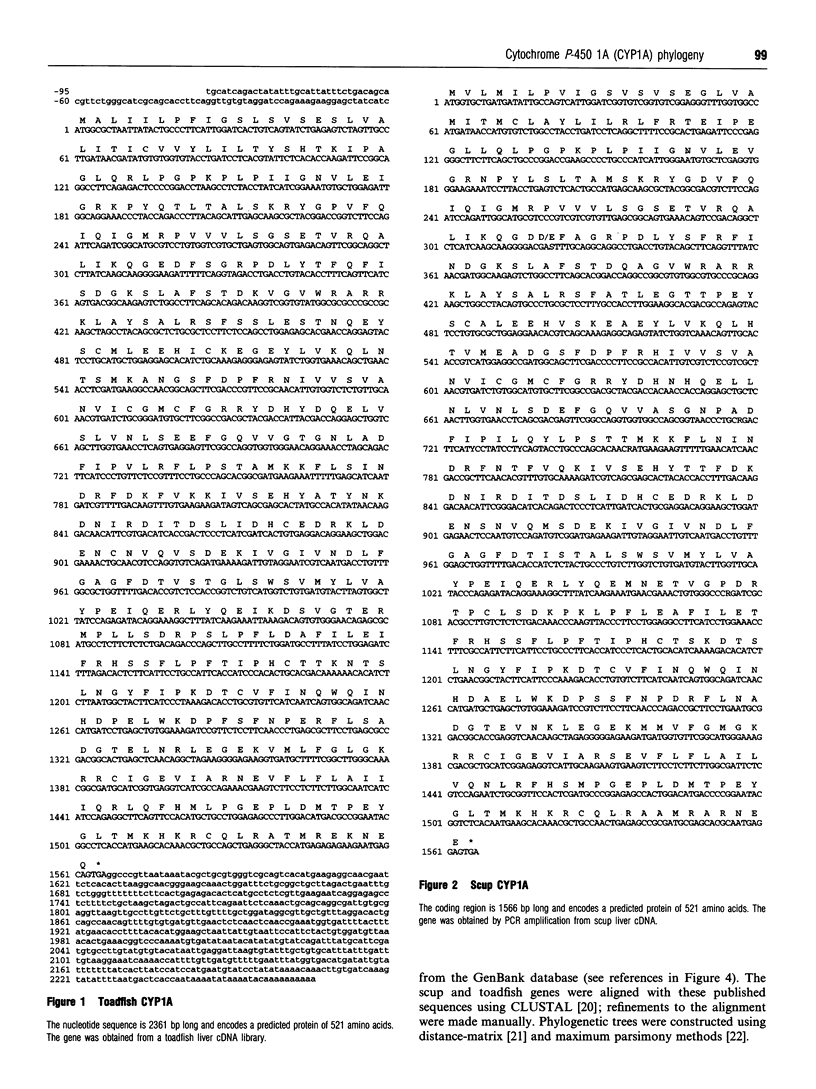
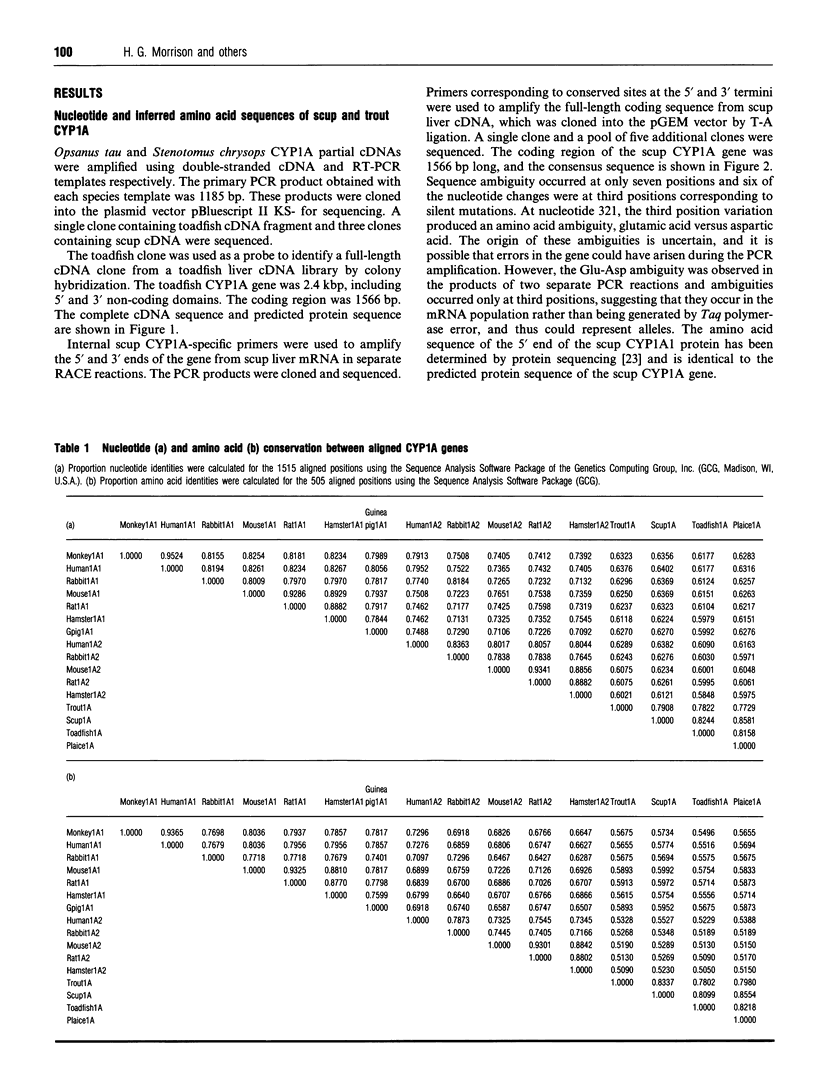
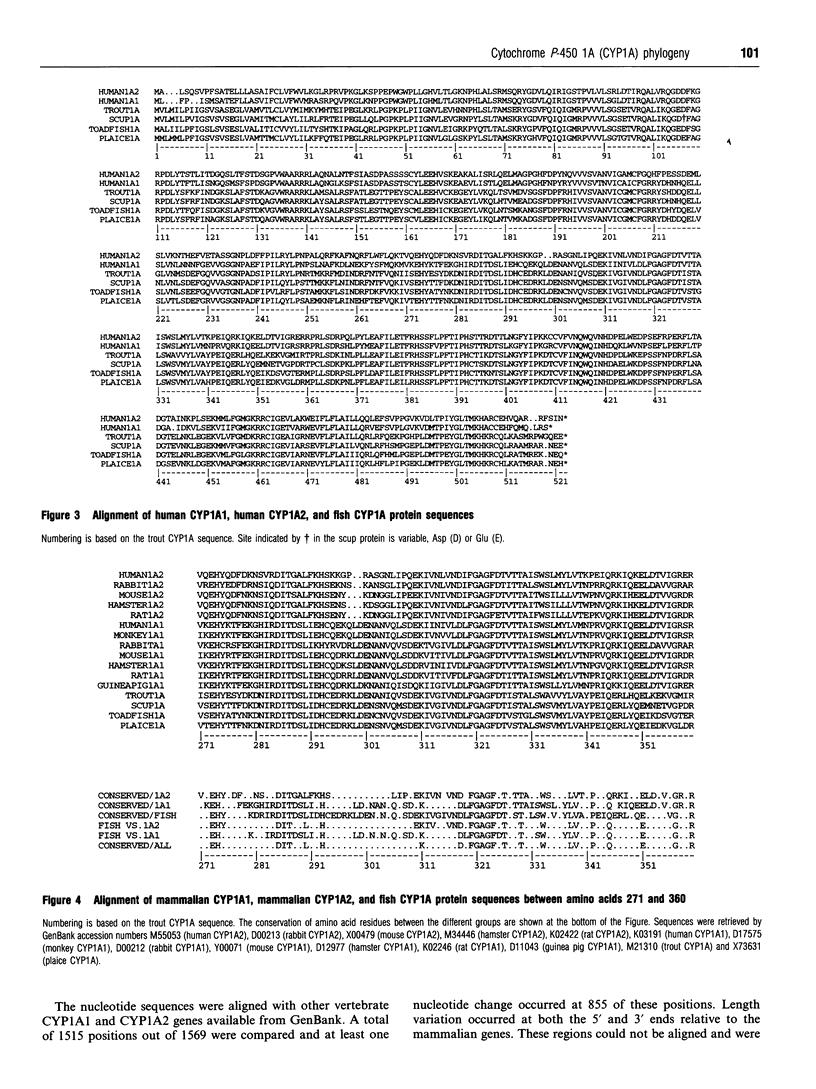
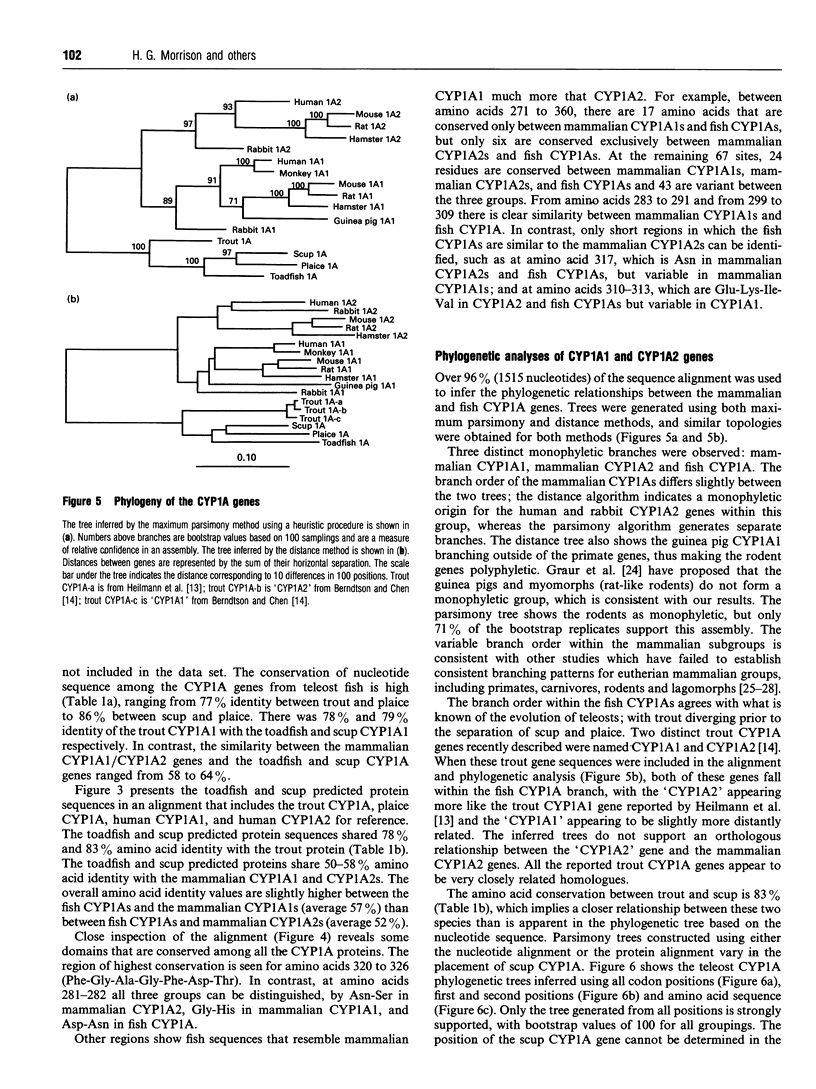
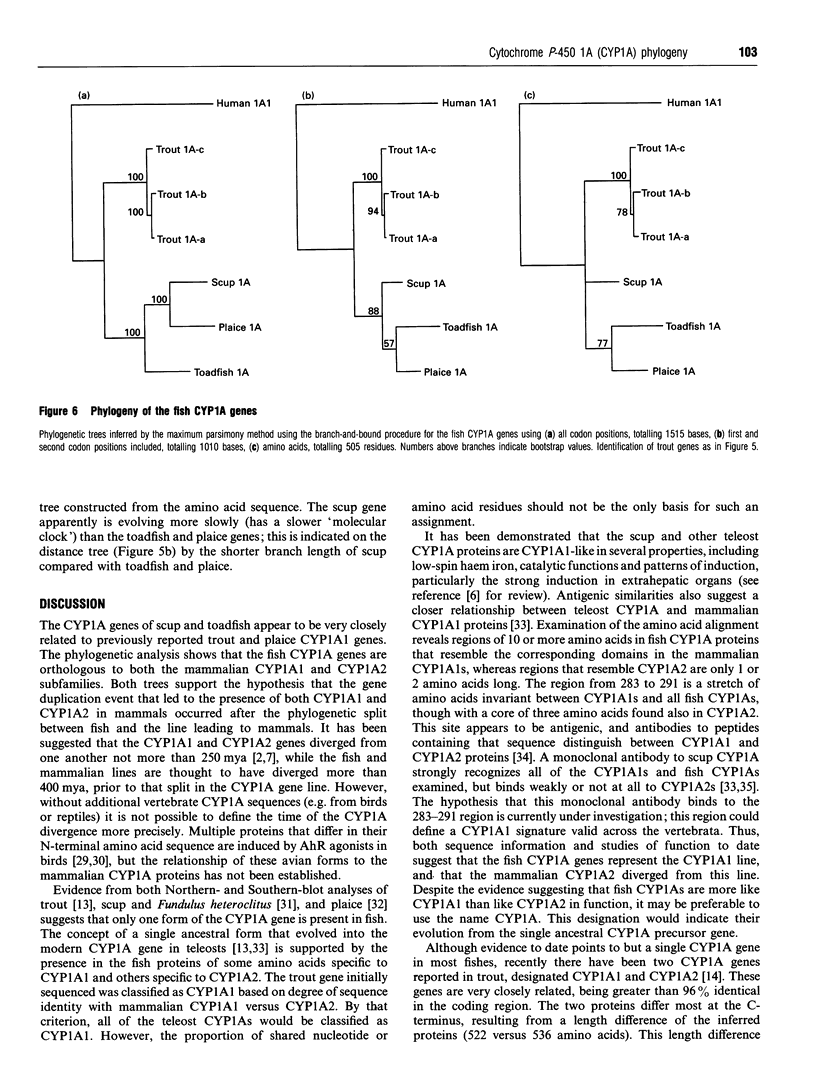
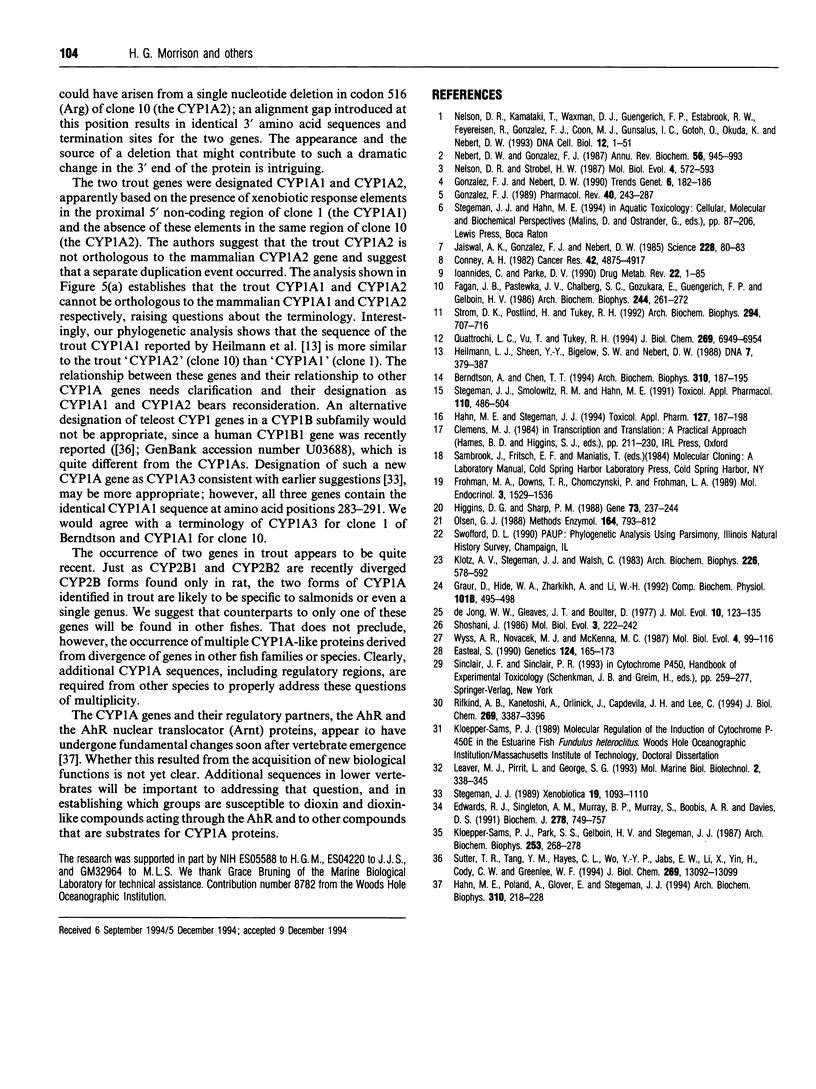
Selected References
These references are in PubMed. This may not be the complete list of references from this article.
- Berndtson A. K., Chen T. T. Two unique CYP1 genes are expressed in response to 3-methylcholanthrene treatment in rainbow trout. Arch Biochem Biophys. 1994 Apr;310(1):187–195. doi: 10.1006/abbi.1994.1156. [DOI] [PubMed] [Google Scholar]
- Conney A. H. Induction of microsomal enzymes by foreign chemicals and carcinogenesis by polycyclic aromatic hydrocarbons: G. H. A. Clowes Memorial Lecture. Cancer Res. 1982 Dec;42(12):4875–4917. [PubMed] [Google Scholar]
- Easteal S. The pattern of mammalian evolution and the relative rate of molecular evolution. Genetics. 1990 Jan;124(1):165–173. doi: 10.1093/genetics/124.1.165. [DOI] [PMC free article] [PubMed] [Google Scholar]
- Edwards R. J., Singleton A. M., Murray B. P., Murray S., Boobis A. R., Davies D. S. Identification of a functionally conserved surface region of rat cytochromes P450IA. Biochem J. 1991 Sep 15;278(Pt 3):749–757. doi: 10.1042/bj2780749. [DOI] [PMC free article] [PubMed] [Google Scholar]
- Fagan J. B., Pastewka J. V., Chalberg S. C., Gozukara E., Guengerich F. P., Gelboin H. V. Noncoordinate regulation of the mRNAs encoding cytochromes P-450BNF/MC-B and P-450ISF/BNF-G. Arch Biochem Biophys. 1986 Jan;244(1):261–272. doi: 10.1016/0003-9861(86)90116-5. [DOI] [PubMed] [Google Scholar]
- Frohman M. A., Downs T. R., Chomczynski P., Frohman L. A. Cloning and characterization of mouse growth hormone-releasing hormone (GRH) complementary DNA: increased GRH messenger RNA levels in the growth hormone-deficient lit/lit mouse. Mol Endocrinol. 1989 Oct;3(10):1529–1536. doi: 10.1210/mend-3-10-1529. [DOI] [PubMed] [Google Scholar]
- Gonzalez F. J., Nebert D. W. Evolution of the P450 gene superfamily: animal-plant 'warfare', molecular drive and human genetic differences in drug oxidation. Trends Genet. 1990 Jun;6(6):182–186. doi: 10.1016/0168-9525(90)90174-5. [DOI] [PubMed] [Google Scholar]
- Gonzalez F. J. The molecular biology of cytochrome P450s. Pharmacol Rev. 1988 Dec;40(4):243–288. [PubMed] [Google Scholar]
- Graur D., Hide W. A., Zharkikh A., Li W. H. The biochemical phylogeny of guinea-pigs and gundis, and the paraphyly of the order rodentia. Comp Biochem Physiol B. 1992 Apr;101(4):495–498. doi: 10.1016/0305-0491(92)90327-n. [DOI] [PubMed] [Google Scholar]
- Hahn M. E., Poland A., Glover E., Stegeman J. J. Photoaffinity labeling of the Ah receptor: phylogenetic survey of diverse vertebrate and invertebrate species. Arch Biochem Biophys. 1994 Apr;310(1):218–228. doi: 10.1006/abbi.1994.1160. [DOI] [PubMed] [Google Scholar]
- Hahn M. E., Stegeman J. J. Regulation of cytochrome P4501A1 in teleosts: sustained induction of CYP1A1 mRNA, protein, and catalytic activity by 2,3,7,8-tetrachlorodibenzofuran in the marine fish Stenotomus chrysops. Toxicol Appl Pharmacol. 1994 Aug;127(2):187–198. doi: 10.1006/taap.1994.1153. [DOI] [PubMed] [Google Scholar]
- Heilmann L. J., Sheen Y. Y., Bigelow S. W., Nebert D. W. Trout P450IA1: cDNA and deduced protein sequence, expression in liver, and evolutionary significance. DNA. 1988 Jul-Aug;7(6):379–387. doi: 10.1089/dna.1.1988.7.379. [DOI] [PubMed] [Google Scholar]
- Higgins D. G., Sharp P. M. CLUSTAL: a package for performing multiple sequence alignment on a microcomputer. Gene. 1988 Dec 15;73(1):237–244. doi: 10.1016/0378-1119(88)90330-7. [DOI] [PubMed] [Google Scholar]
- Ioannides C., Parke D. V. The cytochrome P450 I gene family of microsomal hemoproteins and their role in the metabolic activation of chemicals. Drug Metab Rev. 1990;22(1):1–85. doi: 10.3109/03602539008991444. [DOI] [PubMed] [Google Scholar]
- Jaiswal A. K., Gonzalez F. J., Nebert D. W. Human dioxin-inducible cytochrome P1-450: complementary DNA and amino acid sequence. Science. 1985 Apr 5;228(4695):80–83. doi: 10.1126/science.3838385. [DOI] [PubMed] [Google Scholar]
- Kloepper-Sams P. J., Park S. S., Gelboin H. V., Stegeman J. J. Specificity and cross-reactivity of monoclonal and polyclonal antibodies against cytochrome P-450E of the marine fish scup. Arch Biochem Biophys. 1987 Feb 15;253(1):268–278. doi: 10.1016/0003-9861(87)90660-6. [DOI] [PubMed] [Google Scholar]
- Klotz A. V., Stegeman J. J., Walsh C. An aryl hydrocarbon hydroxylating hepatic cytochrome P-450 from the marine fish Stenotomus chrysops. Arch Biochem Biophys. 1983 Oct 15;226(2):578–592. doi: 10.1016/0003-9861(83)90327-2. [DOI] [PubMed] [Google Scholar]
- Leaver M. J., Pirrit L., George S. G. Cytochrome P450 1A1 cDNA from plaice (Pleuronectes platessa) and induction of P450 1A1 mRNA in various tissues by 3-methylcholanthrene and isosafrole. Mol Mar Biol Biotechnol. 1993 Dec;2(6):338–345. [PubMed] [Google Scholar]
- Nebert D. W., Gonzalez F. J. P450 genes: structure, evolution, and regulation. Annu Rev Biochem. 1987;56:945–993. doi: 10.1146/annurev.bi.56.070187.004501. [DOI] [PubMed] [Google Scholar]
- Nelson D. R., Kamataki T., Waxman D. J., Guengerich F. P., Estabrook R. W., Feyereisen R., Gonzalez F. J., Coon M. J., Gunsalus I. C., Gotoh O. The P450 superfamily: update on new sequences, gene mapping, accession numbers, early trivial names of enzymes, and nomenclature. DNA Cell Biol. 1993 Jan-Feb;12(1):1–51. doi: 10.1089/dna.1993.12.1. [DOI] [PubMed] [Google Scholar]
- Nelson D. R., Strobel H. W. Evolution of cytochrome P-450 proteins. Mol Biol Evol. 1987 Nov;4(6):572–593. doi: 10.1093/oxfordjournals.molbev.a040471. [DOI] [PubMed] [Google Scholar]
- Olsen G. J. Phylogenetic analysis using ribosomal RNA. Methods Enzymol. 1988;164:793–812. doi: 10.1016/s0076-6879(88)64084-5. [DOI] [PubMed] [Google Scholar]
- Quattrochi L. C., Vu T., Tukey R. H. The human CYP1A2 gene and induction by 3-methylcholanthrene. A region of DNA that supports AH-receptor binding and promoter-specific induction. J Biol Chem. 1994 Mar 4;269(9):6949–6954. [PubMed] [Google Scholar]
- Rifkind A. B., Kanetoshi A., Orlinick J., Capdevila J. H., Lee C. Purification and biochemical characterization of two major cytochrome P-450 isoforms induced by 2,3,7,8-tetrachlorodibenzo-p-dioxin in chick embryo liver. J Biol Chem. 1994 Feb 4;269(5):3387–3396. [PubMed] [Google Scholar]
- Shoshani J. Mammalian phylogeny: comparison of morphological and molecular results. Mol Biol Evol. 1986 May;3(3):222–242. doi: 10.1093/oxfordjournals.molbev.a040389. [DOI] [PubMed] [Google Scholar]
- Stegeman J. J. Cytochrome P450 forms in fish: catalytic, immunological and sequence similarities. Xenobiotica. 1989 Oct;19(10):1093–1110. doi: 10.3109/00498258909043164. [DOI] [PubMed] [Google Scholar]
- Stegeman J. J., Smolowitz R. M., Hahn M. E. Immunohistochemical localization of environmentally induced cytochrome P450IA1 in multiple organs of the marine teleost Stenotomus chrysops (Scup). Toxicol Appl Pharmacol. 1991 Sep 15;110(3):486–504. doi: 10.1016/0041-008x(91)90049-k. [DOI] [PubMed] [Google Scholar]
- Strom D. K., Postlind H., Tukey R. H. Characterization of the rabbit CYP1A1 and CYP1A2 genes: developmental and dioxin-inducible expression of rabbit liver P4501A1 and P4501A2. Arch Biochem Biophys. 1992 May 1;294(2):707–716. doi: 10.1016/0003-9861(92)90745-i. [DOI] [PubMed] [Google Scholar]
- Sutter T. R., Tang Y. M., Hayes C. L., Wo Y. Y., Jabs E. W., Li X., Yin H., Cody C. W., Greenlee W. F. Complete cDNA sequence of a human dioxin-inducible mRNA identifies a new gene subfamily of cytochrome P450 that maps to chromosome 2. J Biol Chem. 1994 May 6;269(18):13092–13099. [PubMed] [Google Scholar]
- Wyss A. R., Novacek M. J., McKenna M. C. Amino acid sequence versus morphological data and the interordinal relationships of mammals. Mol Biol Evol. 1987 Mar;4(2):99–116. doi: 10.1093/oxfordjournals.molbev.a040435. [DOI] [PubMed] [Google Scholar]
- de Jung W. W., Gleaves J. T., Boulter D. Evolutionary changes of alpha-crystallin and the phylogeny of mammalian orders. J Mol Evol. 1977 Nov 25;10(2):123–135. doi: 10.1007/BF01751806. [DOI] [PubMed] [Google Scholar]


